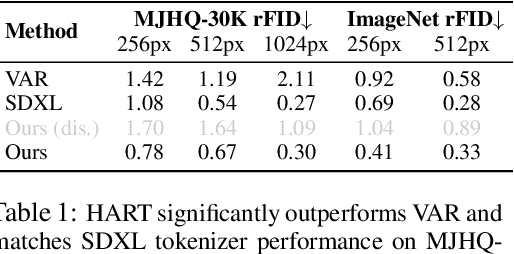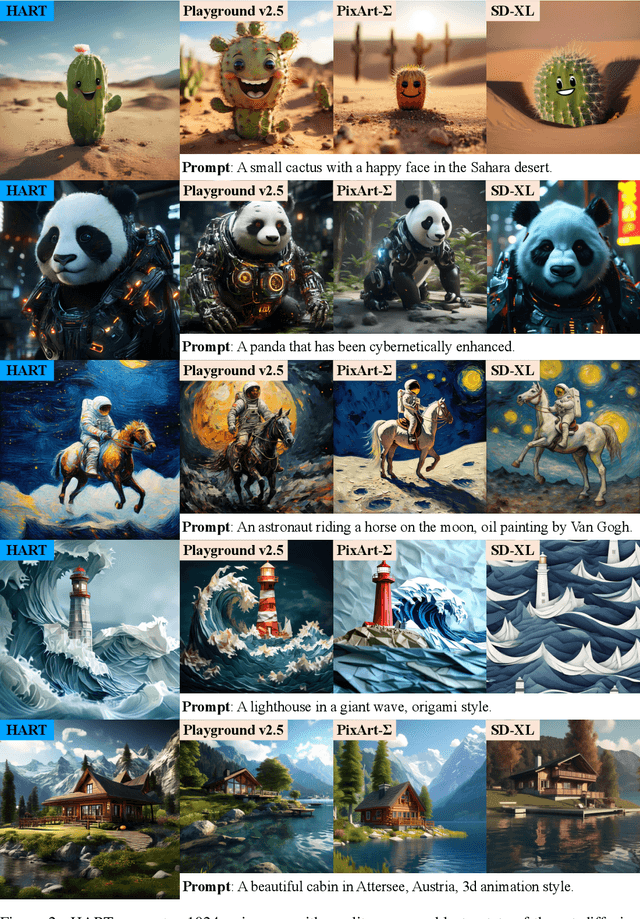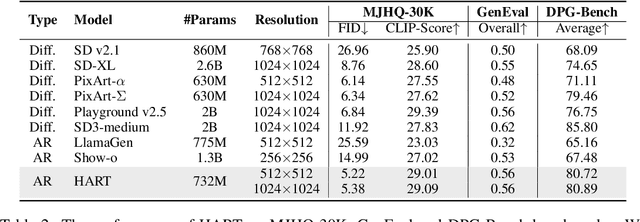Han Cai
Win Fast or Lose Slow: Balancing Speed and Accuracy in Latency-Sensitive Decisions of LLMs
May 26, 2025Abstract:Large language models (LLMs) have shown remarkable performance across diverse reasoning and generation tasks, and are increasingly deployed as agents in dynamic environments such as code generation and recommendation systems. However, many real-world applications, such as high-frequency trading and real-time competitive gaming, require decisions under strict latency constraints, where faster responses directly translate into higher rewards. Despite the importance of this latency quality trade off, it remains underexplored in the context of LLM based agents. In this work, we present the first systematic study of this trade off in real time decision making tasks. To support our investigation, we introduce two new benchmarks: HFTBench, a high frequency trading simulation, and StreetFighter, a competitive gaming platform. Our analysis reveals that optimal latency quality balance varies by task, and that sacrificing quality for lower latency can significantly enhance downstream performance. To address this, we propose FPX, an adaptive framework that dynamically selects model size and quantization level based on real time demands. Our method achieves the best performance on both benchmarks, improving win rate by up to 80% in Street Fighter and boosting daily yield by up to 26.52% in trading, underscoring the need for latency aware evaluation and deployment strategies for LLM based agents. These results demonstrate the critical importance of latency aware evaluation and deployment strategies for real world LLM based agents. Our benchmarks are available at Latency Sensitive Benchmarks.
Sparse VideoGen2: Accelerate Video Generation with Sparse Attention via Semantic-Aware Permutation
May 24, 2025Abstract:Diffusion Transformers (DiTs) are essential for video generation but suffer from significant latency due to the quadratic complexity of attention. By computing only critical tokens, sparse attention reduces computational costs and offers a promising acceleration approach. However, we identify that existing methods fail to approach optimal generation quality under the same computation budget for two reasons: (1) Inaccurate critical token identification: current methods cluster tokens based on position rather than semantics, leading to imprecise aggregated representations. (2) Excessive computation waste: critical tokens are scattered among non-critical ones, leading to wasted computation on GPUs, which are optimized for processing contiguous tokens. In this paper, we propose SVG2, a training-free framework that maximizes identification accuracy and minimizes computation waste, achieving a Pareto frontier trade-off between generation quality and efficiency. The core of SVG2 is semantic-aware permutation, which clusters and reorders tokens based on semantic similarity using k-means. This approach ensures both a precise cluster representation, improving identification accuracy, and a densified layout of critical tokens, enabling efficient computation without padding. Additionally, SVG2 integrates top-p dynamic budget control and customized kernel implementations, achieving up to 2.30x and 1.89x speedup while maintaining a PSNR of up to 30 and 26 on HunyuanVideo and Wan 2.1, respectively.
Scaling Vision Pre-Training to 4K Resolution
Mar 25, 2025Abstract:High-resolution perception of visual details is crucial for daily tasks. Current vision pre-training, however, is still limited to low resolutions (e.g., 378 x 378 pixels) due to the quadratic cost of processing larger images. We introduce PS3 that scales CLIP-style vision pre-training to 4K resolution with a near-constant cost. Instead of contrastive learning on global image representation, PS3 is pre-trained by selectively processing local regions and contrasting them with local detailed captions, enabling high-resolution representation learning with greatly reduced computational overhead. The pre-trained PS3 is able to both encode the global image at low resolution and selectively process local high-resolution regions based on their saliency or relevance to a text prompt. When applying PS3 to multi-modal LLM (MLLM), the resulting model, named VILA-HD, significantly improves high-resolution visual perception compared to baselines without high-resolution vision pre-training such as AnyRes and S^2 while using up to 4.3x fewer tokens. PS3 also unlocks appealing scaling properties of VILA-HD, including scaling up resolution for free and scaling up test-time compute for better performance. Compared to state of the arts, VILA-HD outperforms previous MLLMs such as NVILA and Qwen2-VL across multiple benchmarks and achieves better efficiency than latest token pruning approaches. Finally, we find current benchmarks do not require 4K-resolution perception, which motivates us to propose 4KPro, a new benchmark of image QA at 4K resolution, on which VILA-HD outperforms all previous MLLMs, including a 14.5% improvement over GPT-4o, and a 3.2% improvement and 2.96x speedup over Qwen2-VL.
Sparse VideoGen: Accelerating Video Diffusion Transformers with Spatial-Temporal Sparsity
Feb 03, 2025



Abstract:Diffusion Transformers (DiTs) dominate video generation but their high computational cost severely limits real-world applicability, usually requiring tens of minutes to generate a few seconds of video even on high-performance GPUs. This inefficiency primarily arises from the quadratic computational complexity of 3D Full Attention with respect to the context length. In this paper, we propose a training-free framework termed Sparse VideoGen (SVG) that leverages the inherent sparsity in 3D Full Attention to boost inference efficiency. We reveal that the attention heads can be dynamically classified into two groups depending on distinct sparse patterns: (1) Spatial Head, where only spatially-related tokens within each frame dominate the attention output, and (2) Temporal Head, where only temporally-related tokens across different frames dominate. Based on this insight, SVG proposes an online profiling strategy to capture the dynamic sparse patterns and predicts the type of attention head. Combined with a novel hardware-efficient tensor layout transformation and customized kernel implementations, SVG achieves up to 2.28x and 2.33x end-to-end speedup on CogVideoX-v1.5 and HunyuanVideo, respectively, while preserving generation quality.
SANA 1.5: Efficient Scaling of Training-Time and Inference-Time Compute in Linear Diffusion Transformer
Jan 30, 2025



Abstract:This paper presents SANA-1.5, a linear Diffusion Transformer for efficient scaling in text-to-image generation. Building upon SANA-1.0, we introduce three key innovations: (1) Efficient Training Scaling: A depth-growth paradigm that enables scaling from 1.6B to 4.8B parameters with significantly reduced computational resources, combined with a memory-efficient 8-bit optimizer. (2) Model Depth Pruning: A block importance analysis technique for efficient model compression to arbitrary sizes with minimal quality loss. (3) Inference-time Scaling: A repeated sampling strategy that trades computation for model capacity, enabling smaller models to match larger model quality at inference time. Through these strategies, SANA-1.5 achieves a text-image alignment score of 0.72 on GenEval, which can be further improved to 0.80 through inference scaling, establishing a new SoTA on GenEval benchmark. These innovations enable efficient model scaling across different compute budgets while maintaining high quality, making high-quality image generation more accessible.
COAT: Compressing Optimizer states and Activation for Memory-Efficient FP8 Training
Oct 25, 2024



Abstract:FP8 training has emerged as a promising method for improving training efficiency. Existing frameworks accelerate training by applying FP8 computation to linear layers while leaving optimizer states and activations in higher precision, which fails to fully optimize memory usage. This paper introduces COAT (Compressing Optimizer States and Activations for FP8 Training), a novel FP8 training framework designed to significantly reduce memory footprint when training large models. COAT addresses current limitations through two key innovations: (1) Dynamic Range Expansion, which aligns optimizer state distributions more closely with the FP8 representation range, thereby reducing quantization error, and (2) Mixed-Granularity Activation Quantization, which optimizes activation memory using a combination of per-tensor and per-group quantization strategies. Experiments demonstrate that COAT effectively reduces end-to-end training memory footprint by 1.54x compared to BF16 while achieving nearly lossless performance across various tasks, such as Large Language Model pretraining and fine-tuning and Vision Language Model training. COAT also achieves a 1.43x end-to-end training speedup compared to BF16, performing on par with or surpassing TransformerEngine's speedup. COAT enables efficient full-parameter training of large models on fewer GPUs, and facilitates doubling the batch size in distributed training settings, providing a practical solution for scaling large-scale model training. The code is available at https://github.com/NVlabs/COAT.
SANA: Efficient High-Resolution Image Synthesis with Linear Diffusion Transformers
Oct 15, 2024



Abstract:We introduce Sana, a text-to-image framework that can efficiently generate images up to 4096$\times$4096 resolution. Sana can synthesize high-resolution, high-quality images with strong text-image alignment at a remarkably fast speed, deployable on laptop GPU. Core designs include: (1) Deep compression autoencoder: unlike traditional AEs, which compress images only 8$\times$, we trained an AE that can compress images 32$\times$, effectively reducing the number of latent tokens. (2) Linear DiT: we replace all vanilla attention in DiT with linear attention, which is more efficient at high resolutions without sacrificing quality. (3) Decoder-only text encoder: we replaced T5 with modern decoder-only small LLM as the text encoder and designed complex human instruction with in-context learning to enhance the image-text alignment. (4) Efficient training and sampling: we propose Flow-DPM-Solver to reduce sampling steps, with efficient caption labeling and selection to accelerate convergence. As a result, Sana-0.6B is very competitive with modern giant diffusion model (e.g. Flux-12B), being 20 times smaller and 100+ times faster in measured throughput. Moreover, Sana-0.6B can be deployed on a 16GB laptop GPU, taking less than 1 second to generate a 1024$\times$1024 resolution image. Sana enables content creation at low cost. Code and model will be publicly released.
Deep Compression Autoencoder for Efficient High-Resolution Diffusion Models
Oct 14, 2024



Abstract:We present Deep Compression Autoencoder (DC-AE), a new family of autoencoder models for accelerating high-resolution diffusion models. Existing autoencoder models have demonstrated impressive results at a moderate spatial compression ratio (e.g., 8x), but fail to maintain satisfactory reconstruction accuracy for high spatial compression ratios (e.g., 64x). We address this challenge by introducing two key techniques: (1) Residual Autoencoding, where we design our models to learn residuals based on the space-to-channel transformed features to alleviate the optimization difficulty of high spatial-compression autoencoders; (2) Decoupled High-Resolution Adaptation, an efficient decoupled three-phases training strategy for mitigating the generalization penalty of high spatial-compression autoencoders. With these designs, we improve the autoencoder's spatial compression ratio up to 128 while maintaining the reconstruction quality. Applying our DC-AE to latent diffusion models, we achieve significant speedup without accuracy drop. For example, on ImageNet 512x512, our DC-AE provides 19.1x inference speedup and 17.9x training speedup on H100 GPU for UViT-H while achieving a better FID, compared with the widely used SD-VAE-f8 autoencoder. Our code is available at https://github.com/mit-han-lab/efficientvit.
HART: Efficient Visual Generation with Hybrid Autoregressive Transformer
Oct 14, 2024



Abstract:We introduce Hybrid Autoregressive Transformer (HART), an autoregressive (AR) visual generation model capable of directly generating 1024x1024 images, rivaling diffusion models in image generation quality. Existing AR models face limitations due to the poor image reconstruction quality of their discrete tokenizers and the prohibitive training costs associated with generating 1024px images. To address these challenges, we present the hybrid tokenizer, which decomposes the continuous latents from the autoencoder into two components: discrete tokens representing the big picture and continuous tokens representing the residual components that cannot be represented by the discrete tokens. The discrete component is modeled by a scalable-resolution discrete AR model, while the continuous component is learned with a lightweight residual diffusion module with only 37M parameters. Compared with the discrete-only VAR tokenizer, our hybrid approach improves reconstruction FID from 2.11 to 0.30 on MJHQ-30K, leading to a 31% generation FID improvement from 7.85 to 5.38. HART also outperforms state-of-the-art diffusion models in both FID and CLIP score, with 4.5-7.7x higher throughput and 6.9-13.4x lower MACs. Our code is open sourced at https://github.com/mit-han-lab/hart.
Condition-Aware Neural Network for Controlled Image Generation
Apr 01, 2024



Abstract:We present Condition-Aware Neural Network (CAN), a new method for adding control to image generative models. In parallel to prior conditional control methods, CAN controls the image generation process by dynamically manipulating the weight of the neural network. This is achieved by introducing a condition-aware weight generation module that generates conditional weight for convolution/linear layers based on the input condition. We test CAN on class-conditional image generation on ImageNet and text-to-image generation on COCO. CAN consistently delivers significant improvements for diffusion transformer models, including DiT and UViT. In particular, CAN combined with EfficientViT (CaT) achieves 2.78 FID on ImageNet 512x512, surpassing DiT-XL/2 while requiring 52x fewer MACs per sampling step.
 Add to Chrome
Add to Chrome Add to Firefox
Add to Firefox Add to Edge
Add to Edge